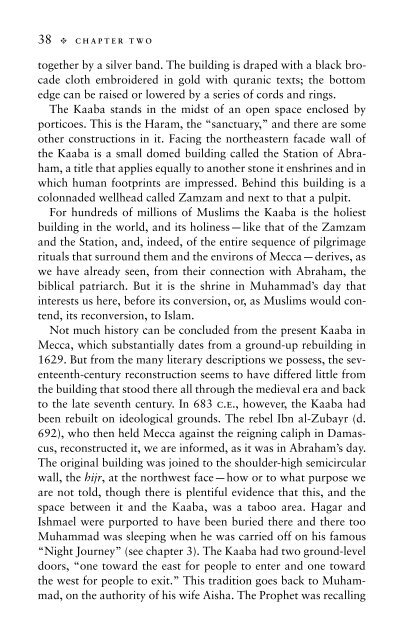Islam: A Guide for Jews and Christians - Electric Scotland
Islam: A Guide for Jews and Christians - Electric Scotland
Islam: A Guide for Jews and Christians - Electric Scotland
Create successful ePaper yourself
Turn your PDF publications into a flip-book with our unique Google optimized e-Paper software.
38 t CHAPTER TWO<br />
together by a silver b<strong>and</strong>. The building is draped with a black brocade<br />
cloth embroidered in gold with quranic texts; the bottom<br />
edge can be raised or lowered by a series of cords <strong>and</strong> rings.<br />
The Kaaba st<strong>and</strong>s in the midst of an open space enclosed by<br />
porticoes. This is the Haram, the “sanctuary,” <strong>and</strong> there are some<br />
other constructions in it. Facing the northeastern facade wall of<br />
the Kaaba is a small domed building called the Station of Abraham,<br />
a title that applies equally to another stone it enshrines <strong>and</strong> in<br />
which human footprints are impressed. Behind this building is a<br />
colonnaded wellhead called Zamzam <strong>and</strong> next to that a pulpit.<br />
For hundreds of millions of Muslims the Kaaba is the holiest<br />
building in the world, <strong>and</strong> its holiness—like that of the Zamzam<br />
<strong>and</strong> the Station, <strong>and</strong>, indeed, of the entire sequence of pilgrimage<br />
rituals that surround them <strong>and</strong> the environs of Mecca—derives, as<br />
we have already seen, from their connection with Abraham, the<br />
biblical patriarch. But it is the shrine in Muhammad’s day that<br />
interests us here, be<strong>for</strong>e its conversion, or, as Muslims would contend,<br />
its reconversion, to <strong>Islam</strong>.<br />
Not much history can be concluded from the present Kaaba in<br />
Mecca, which substantially dates from a ground-up rebuilding in<br />
1629. But from the many literary descriptions we possess, the seventeenth-century<br />
reconstruction seems to have differed little from<br />
the building that stood there all through the medieval era <strong>and</strong> back<br />
to the late seventh century. In 683 c.e., however, the Kaaba had<br />
been rebuilt on ideological grounds. The rebel Ibn al-Zubayr (d.<br />
692), who then held Mecca against the reigning caliph in Damascus,<br />
reconstructed it, we are in<strong>for</strong>med, as it was in Abraham’s day.<br />
The original building was joined to the shoulder-high semicircular<br />
wall, the hijr, at the northwest face—how or to what purpose we<br />
are not told, though there is plentiful evidence that this, <strong>and</strong> the<br />
space between it <strong>and</strong> the Kaaba, was a taboo area. Hagar <strong>and</strong><br />
Ishmael were purported to have been buried there <strong>and</strong> there too<br />
Muhammad was sleeping when he was carried off on his famous<br />
“Night Journey” (see chapter 3). The Kaaba had two ground-level<br />
doors, “one toward the east <strong>for</strong> people to enter <strong>and</strong> one toward<br />
the west <strong>for</strong> people to exit.” This tradition goes back to Muhammad,<br />
on the authority of his wife Aisha. The Prophet was recalling
















